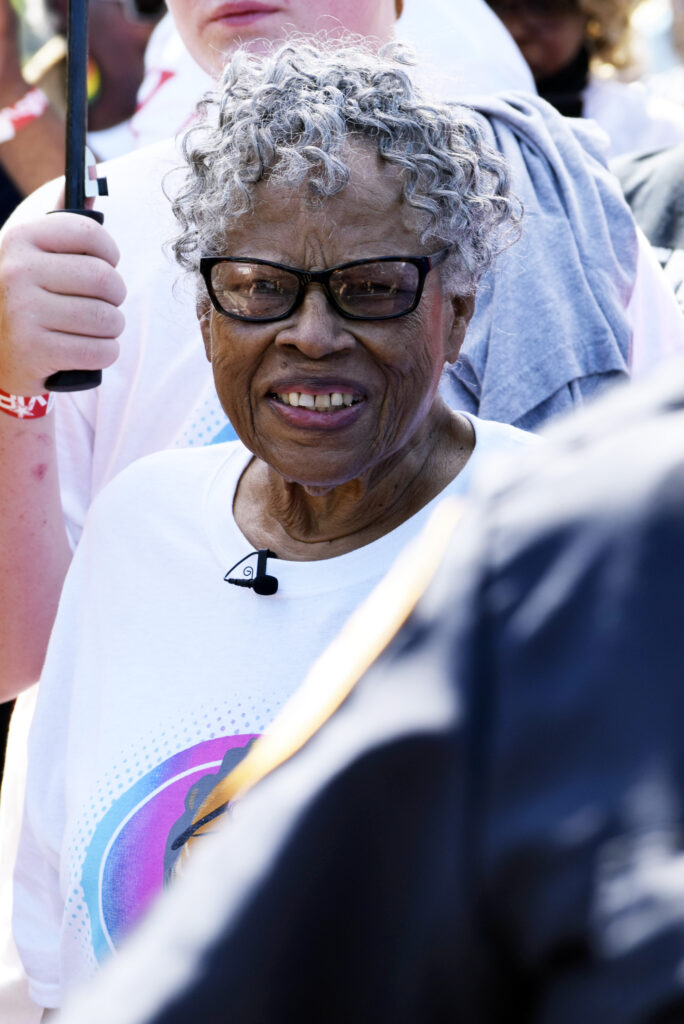Opal Lee’s dream of a building to commemorate the “breaking of the chains” is moving closer to fruition as she and her team have unveiled design renderings for the National Juneteenth Museum, to be located in Fort Worth’s Historic Southside.
The 50,000-square-foot museum, which will be built in the 900 block of East Rosedale Street, is expected to break ground in 2023 and be open to the public on June 19, 2025. It will host exhibits, discussions and events about the significance of the path to freedom for slaves in Texas and other African Americans following the end of the Civil War.
It will also further enhance the growing legacy of Lee, the Fort Worth educator, community activist and 2022 Nobel Peace Prize nominee who has long been known as the “Grandmother of Juneteenth.”
“Seeing the national museum moving forward is a dream fulfilled,” said the 95-year-old Lee, who has had her own small Juneteenth Museum in that location for almost two decades. “To see it become a central place for discussion, collaboration and learning seems to be the providential next step. It’s mind-boggling, but I’m glad to see it all come to pass.”
The project design embraces the local African American experience through motifs and symbolic touchpoints inspired by the gabled rooftops that define the Historic Southside neighborhood and the “nova star” representing a new chapter for African Americans looking ahead to a more just future.
At the center of the museum’s publicly accessible courtyard is a five point star engraved in gold to represent Texas, the last state to acknowledge the freedom of African American slaves. It is also a nod to the American flag’s 50 stars, representing the freedom of African Americans across the country.
The collaborative team is led by the Bjarke Ingels Group (BIG) and North Texas-based architect of record KAI Enterprises.
“Our hope is that this building will become a gateway to the Historic Southside community of Fort Worth while serving as a national and global destination,” said BIG partner Douglass Alligood. “Juneteenth is not only American history, it is world history.”
Juneteenth celebrates the “breaking of the chains,” the legacy of freedom announced in Galveston on June 19, 1865 – more than two years after President Abraham Lincoln issued the Emancipation Proclamation. With Opal Lee on hand at the White House, President Joe Biden signed legislation last June making Juneteenth the 11th federal holiday.
Lee gained national attention in 2016, when at 89, she began a 1,400-mile trek from Fort Worth to Washington, D.C., to petition for the recognition of Juneteenth as a national holiday, Her petitions gathered more than a million signatures.
“To have lived long enough to see my walking and talking make an impact is one thing,” Lee said, “but to know that a state-of-the-art museum will house the actual pen that President Biden used to sign the bill and many other exhibits are coming to pass as well … I could do my holy dance again.”
“Looking at the renderings of the museum brings tears to my eyes,” said District 5 City Council representative and Mayor Pro Tem Gyna Bivens. “I am delighted that Ms. Opal Lee has surrounded herself with a team that embraces her vision, which is a blessing to us all. Who knew a property that was often the discussion of code violations would become a national must-see destination location?”
“This state-of-the-art design is very innovative and exciting for a museum that has so much meaning,” said District 8 Councilman Chris Nettles. “This is what revitalization looks like for a community full of potential and armed with a great vision. The open concept and gorgeous architecture gives us hope that we too can achieve healthy, empowering developments along I-35.”
District 9 Councilwoman Elizabeth Beck said Fort Worth is “the perfect place” for the museum, given the city’s identification with Opal Lee.
The site of the museum is also where, in 1939, Charles Stowe was on a mission to keep the southside neighborhood he lived in white. He organized a local Anglo-Saxon committee that posted signs throughout the neighborhood with comments such as, “Negroes take notice. Don’t move into this area!” and threatened white homeowners who planned to sell to black families.
As white homeowners left, black families, including Lee’s, moved into the neighborhood. On June 19, 1939, three days after her family settled into their home on East Annie Street, the house was destroyed in a fire set by a racist mob. That pivotal night was a catalyst to Lee’s decades-long effort to make Juneteenth a national holiday.
The National Juneteenth Museum will be built in Fort Worth as part of a mixed-use development that will help revitalize the city’s Historic Southside neighborhood. The museum’s funding comes from multiple sources, including private and corporate donations, government programs, foundations and grants.
“Juneteenth is truly the celebration of freedom for all people,” District 3 Councilman Michael Crain said. “It is an honor for Fort Worth to be the home of such a historic museum recognizing such an important moment in our country’s history.”
Douglass Alligood said his role in designing a project focused on African American culture is important to him not only on a professional level but personally as well.
“Our engagement with Ms. Opal Lee and members of the community, to really understand their needs, is what informed a lot of the design principles,” he said. “As a black architect, this project is one of the most rewarding experiences of my career.”







